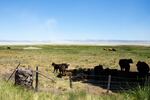
FILE: Cows sit in the shade near the edge of a dry Summer Lake near Summer Lake, Ore., on the hottest day of the year, June 28, 2021.
Bradley W. Parks / OPB
Many parts of the American West, including Oregon, have entered or will enter a state of “perpetual drought” if global warming, driven by the burning of fossil fuels, continues unabated.
That’s according to a new paper published in the Proceedings of the National Academy of Sciences this week.
“We’re not coming back to any kind of normal by today’s standards,” said Samantha Stevenson, the paper’s lead author and an assistant professor at the University of California, Santa Barbara.
Normal refers to the amount of water expected to be available for people, plants and animals at any given time. When the actual amount of water available falls short of that norm, experts call it a drought.
The researchers used climate models to predict future precipitation and soil moisture levels, assuming that greenhouse gas emissions stay high. They found that what’s now considered a long-lasting and intense drought in parts of the American West is becoming the norm over time.
That’s the case in Oregon, which is gradually drying out.
More than one-third of Oregon, on average, has been in severe drought or worse from 2000 to 2020, according to the fifth and latest Oregon Climate Assessment. Three-quarters of the state remained in severe drought or worse this week.
“Our climate is becoming drier,” said Erica Fleishman, director of the Oregon Climate Change Research Institute, which publishes the assessment. “And what we thought of as ‘normal’ water availability 50 years ago is just not something that we can consider normal anymore — and we’re seeing that statewide.”
Historically, Oregon had wet seasons and dry seasons. Rain soaked the western portion of the state in the winter while snow blanketed mountain ranges. Central and Eastern Oregon especially relied on a gradual melting of that mountain snowpack to feed rivers and streams throughout the summer.
As the state becomes drier, Fleishman said, Oregon will continue to have wet days, but what Oregonians know as a wet season may become a thing of the past.
“That leads to questions about what can be supported across the state,” Fleishman said. “It’s not just the amount of water that we need to be thinking about, it’s what are some of the secondary effects of having less water.”
The shifting definition of normal presents challenges to humans, whose built environment is constructed around a fixed definition of normal and a range of extremes. Plants and animals too often depend on water allocated to them by people.
Adapting to this particular effect of climate change, Stevenson said, requires a shifting baseline or definition of normal and, thus, a more fluid definition of drought.
“If we are managing [water] with the expectation that any drought that begins will be temporary and we will recover back to where we started, that’s probably not an accurate assumption,” Stevenson said. “We should plan for any recovery to come back to a slightly drier state than where we were when the drought started.”
According to the study, both parched and wet places will still experience wetter-than-average times and drier-than-average times, but there will be new averages and new extremes.
“Climate change is here,” Stevenson said. “So we need to be thinking right now about what changes we need to make to our policy systems and our social systems in order to be prepared.”
